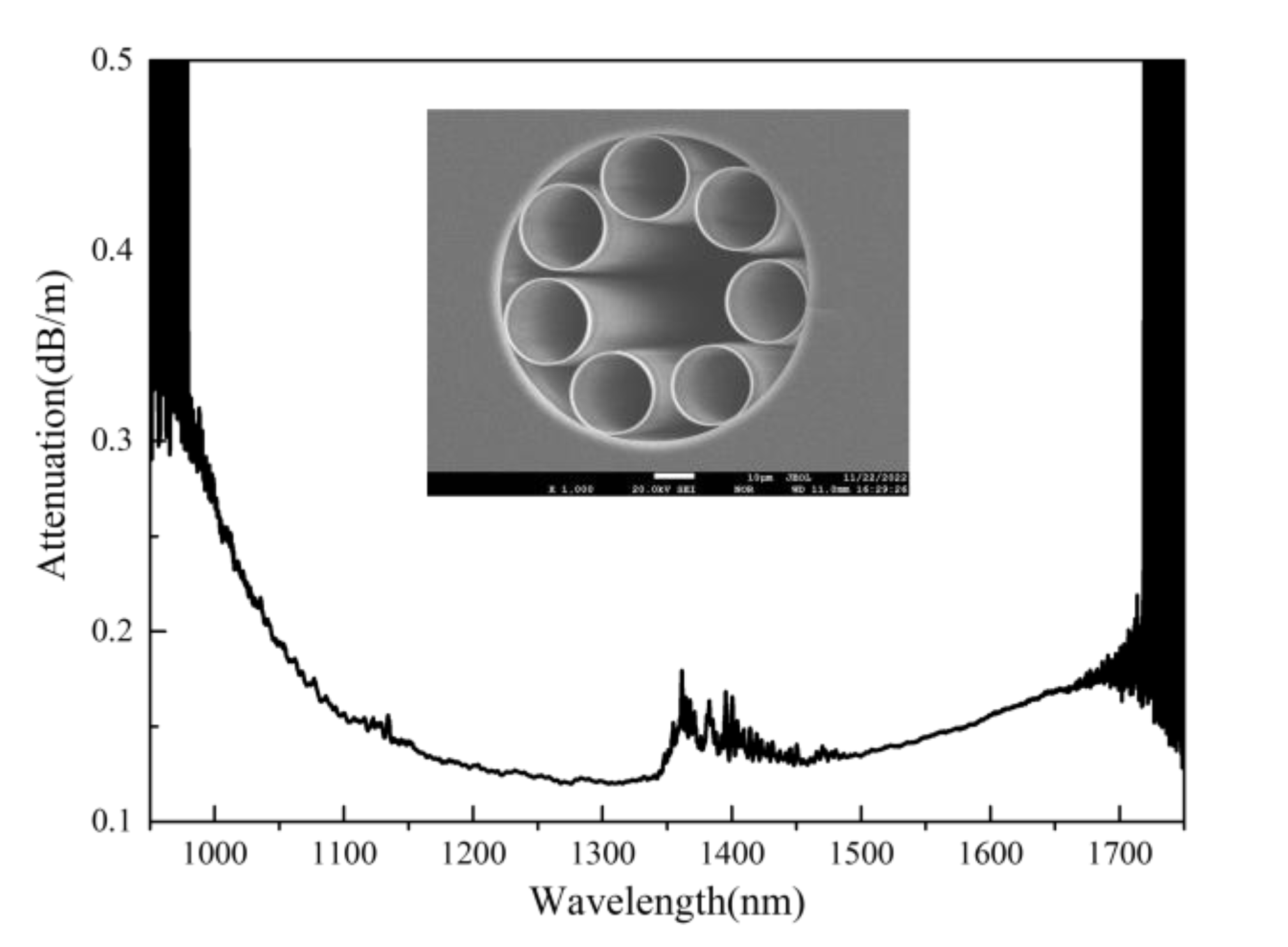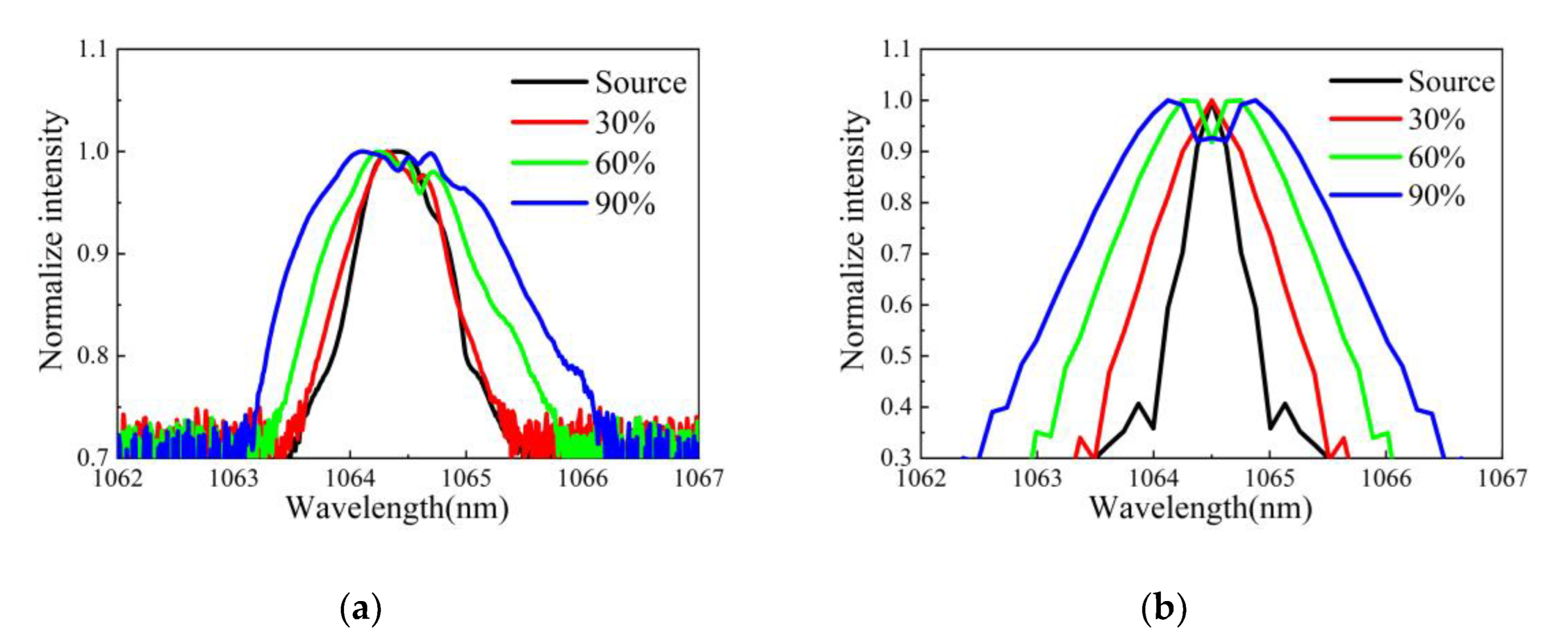Delivery of Nearly Diffraction-Limited Picosecond Laser Pulses in the Air-Filled Anti-Resonant Hollow-Core Fiber at 1 μm Wavelength
Abstract
:1. Introduction
2. Experiment
2.1. AR-HCF
2.2. Picosecond Pulsed Laser Source
2.3. Experimental Setup
3. Results
3.1. Characterization of Power Transmission
3.2. Characterization of Laser Beam Profile
3.3. Characterization of Laser Delivery in the Spectral and Temporal Domains
4. Discussion on Pulse Compression in the Air-Filled AR-HCF
4.1. Dispersion of AR-HCF
4.2. Numerical Simulation of Pulse Propagation in AR-HCF
5. Conclusions
Author Contributions
Funding
Institutional Review Board Statement
Informed Consent Statement
Data Availability Statement
Acknowledgments
Conflicts of Interest
References
- Tirlapur, U.K.; König, K. Targeted transfection by femtosecond laser. Nature 2002, 418, 290–291. [Google Scholar] [CrossRef] [PubMed]
- Farsari, M.; Chichkov, B.N. Two-photon fabrication. Nat. Photonics 2009, 3, 450–452. [Google Scholar] [CrossRef]
- Petrarca, M.; Henin, S.; Berti, N.; Matthews, M.; Chagas, J.; Kasparian, J.; Wolf, J.-P.; Gatti, G.; Di Pirro, G.; Anania, M.-P. White-light femtosecond Lidar at 100 TW power level. Appl. Phys. B 2014, 114, 319–325. [Google Scholar] [CrossRef] [Green Version]
- Eilzer, S.; Funck, M.C.; Wedel, B. Industrial fiber beam delivery system for ultrafast lasers: Applications and recent advances. High-Power Laser Mater. Process. Lasers Beam Deliv. Diagn. Appl. V 2016, 9741, 9–17. [Google Scholar]
- Agrawal, G.P. Nonlinear fiber optics. In Nonlinear Science at the Dawn of the 21st Century; Springer: Berlin/Heidelberg, Germany, 2000; pp. 195–211. [Google Scholar]
- Cregan, R.; Mangan, B.; Knight, J.; Birks, T.; Russell, P.S.J.; Roberts, P.; Allan, D. Single-mode photonic band gap guidance of light in air. Science 1999, 285, 1537–1539. [Google Scholar] [CrossRef] [Green Version]
- Hasan, I.; Akhmediev, N.; Chang, W. Empirical formulae for hollow-core antiresonant fibers: Dispersion and effective mode area. arXiv 2017, arXiv:1708.06879. [Google Scholar] [CrossRef]
- Andreana, M.; Le, T.; Drexler, W.; Unterhuber, A. Ultrashort pulse Kagome hollow-core photonic crystal fiber delivery for nonlinear optical imaging. Opt. Lett. 2019, 44, 1588–1591. [Google Scholar] [CrossRef]
- Resan, B.; Auchli, R.; Villamaina, V.; Holtz, R. Dynamic fiber delivery of 3 W 160 fs pulses with photonic crystal hollow core fiber patchcord. Opt. Express 2017, 25, 24553–24558. [Google Scholar] [CrossRef]
- Jones, D.; Bennett, C.; Smith, M.; Scott, A. High-power beam transport through a hollow-core photonic bandgap fiber. Opt. Lett. 2014, 39, 3122–3125. [Google Scholar] [CrossRef]
- Mulvad, H.; Abokhamis Mousavi, S.; Zuba, V.; Xu, L.; Sakr, H.; Bradley, T.; Hayes, J.; Jasion, G.; Numkam Fokoua, E.; Taranta, A. Kilowatt-average-power single-mode laser light transmission over kilometre-scale hollow-core fibre. Nat. Photonics 2022, 16, 448–453. [Google Scholar] [CrossRef]
- Belardi, W.; Knight, J.C. Effect of core boundary curvature on the confinement losses of hollow antiresonant fibers. Opt. Express 2013, 21, 21912–21917. [Google Scholar] [CrossRef] [PubMed]
- Yu, F.; Knight, J.C. Low loss anti-resonant hollow-core fibers and applications. In Proceedings of the 2017 19th International Conference on Transparent Optical Networks (ICTON), Girona, Spain, 2–6 July 2017; pp. 1–4. [Google Scholar]
- Yu, F.; Cann, M.; Brunton, A.; Wadsworth, W.; Knight, J. Single-mode solarization-free hollow-core fiber for ultraviolet pulse delivery. Opt. Express 2018, 26, 10879–10887. [Google Scholar] [CrossRef] [PubMed]
- Gao, S.-F.; Wang, Y.-Y.; Ding, W.; Wang, P. Hollow-core negative-curvature fiber for UV guidance. Opt. Lett. 2018, 43, 1347–1350. [Google Scholar] [CrossRef] [PubMed]
- Jaworski, P.; Yu, F.; Carter, R.M.; Knight, J.C.; Shephard, J.D.; Hand, D.P. High energy green nanosecond and picosecond pulse delivery through a negative curvature fiber for precision micro-machining. Opt. Express 2015, 23, 8498–8506. [Google Scholar] [CrossRef] [Green Version]
- Jaworski, P.; Yu, F.; MacLachlan, D.G.; Maier, R.R.; Thomson, R.R.; Wadsworth, W.J.; Knight, J.C.; Shephard, J.D.; Hand, D.P. A hollow-core Negative Curvature Fibre for efficient delivery of NIR picosecond and femtosecond pulses for precision micro-machining. In Proceedings of the Workshop on Specialty Optical Fibers and their Applications, Sigtuna, Sweden, 28–30 August 2013; p. F3-3. [Google Scholar]
- Krylov, A.A.; Senatorov, A.K.; Pryamikov, A.D.; Kosolapov, A.F.; Kolyadin, A.N.; Alagashev, G.K.; Gladyshev, A.V.; Bufetov, I.A. 1.56 µm sub-microjoule femtosecond pulse delivery through low-loss microstructured revolver hollow-core fiber. Laser Phys. Lett. 2017, 14, 035104. [Google Scholar] [CrossRef]
- Lee, E.; Luo, J.; Sun, B.; Ramalingam, V.L.; Yu, X.; Wang, Q.; Yu, F.; Knight, J.C. 45W 2 μm nanosecond pulse delivery using antiresonant hollow-core fiber. In Proceedings of the 2018 Conference on Lasers and Electro-Optics (CLEO), San Jose, CA, USA, 13–18 May 2018; pp. 1–2. [Google Scholar]
- Eilzer, S.; Wedel, B. Hollow core optical fibers for industrial ultra short pulse laser beam delivery applications. Fibers 2018, 6, 80. [Google Scholar] [CrossRef] [Green Version]
- Boullet, J.; Vinçont, C.; Bérisset, M.; Pierre, C. High energy ultrashort pulse delivery through hollow-core photonic crystal fiber. In Proceedings of the Components and Packaging for Laser Systems VII, Online, 6–11 March 2021; pp. 16–22. [Google Scholar]
- Jaworski, P.; Yu, F.; Maier, R.R.; Wadsworth, W.J.; Knight, J.C.; Shephard, J.D.; Hand, D.P. Picosecond and nanosecond pulse delivery through a hollow-core negative curvature fiber for micro-machining applications. Opt. Express 2013, 21, 22742–22753. [Google Scholar] [CrossRef] [Green Version]
- Michieletto, M.; Lyngsø, J.K.; Jakobsen, C.; Lægsgaard, J.; Bang, O.; Alkeskjold, T.T. Hollow-core fibers for high power pulse delivery. Opt. Express 2016, 24, 7103–7119. [Google Scholar] [CrossRef] [Green Version]
- Fu, Q.; Davidson, I.; Mousavi, S.; Xu, L.; Wheeler, N.; Poletti, F.; Richardson, D. Kilowatt-peak-power Green Pulse Delivery over Hundred-meter Scale Lengths of Hollow-Core Fiber. In Proceedings of the CLEO: Science and Innovations, San Jose, CA, USA, 15–20 May 2022; p. SW4K-8. [Google Scholar]
- Wu, S.; Siwicki, B.; Carter, R.M.; Biancalana, F.; Shephard, J.D.; Hand, D.P. Impact of nonlinear effects on transmission losses of hollow-core antiresonant negative curvature optical fiber. Appl. Opt. 2020, 59, 4988–4996. [Google Scholar] [CrossRef]
- Cai, Y.; Mai, Y.; Xiang, S.; Shi, J.; Zhu, Q.; Li, R.; Li, J.; Li, C.; Yan, D.; Xing, Y. Flexible Beam Delivery of Ultrafast Laser through Vacuum-Pumped Anti-Resonant Hollow-Core Fiber. Front. Phys. 2023, 11, 165. [Google Scholar] [CrossRef]
- Yu, F.; Xu, M.; Knight, J.C. Experimental study of low-loss single-mode performance in anti-resonant hollow-core fibers. Opt. Express 2016, 24, 12969–12975. [Google Scholar] [CrossRef] [PubMed] [Green Version]
- Song, P.; Phoong, K.Y.; Bird, D. Quantitative analysis of anti-resonance in single-ring, hollow-core fibres. Opt. Express 2019, 27, 27745–27760. [Google Scholar] [CrossRef] [PubMed]
- Carter, R.M.; Yu, F.; Wadsworth, W.J.; Shephard, J.D.; Birks, T.; Knight, J.C.; Hand, D.P. Measurement of resonant bend loss in anti-resonant hollow core optical fiber. Opt. Express 2017, 25, 20612–20621. [Google Scholar] [CrossRef] [PubMed]
- Ding, W.; Wang, Y. Analytic model for light guidance in single-wall hollow-core anti-resonant fibers. Opt. Express 2014, 22, 27242–27256. [Google Scholar] [CrossRef]
- Hasan, M.I.; Akhmediev, N.; Chang, W. Empirical formulae for dispersion and effective mode area in hollow-core antiresonant fibers. J. Light. Technol. 2018, 36, 4060–4065. [Google Scholar] [CrossRef]
- Dudley, J.M.; Genty, G.; Coen, S. Supercontinuum generation in photonic crystal fiber. Rev. Mod. Phys. 2006, 78, 1135. [Google Scholar] [CrossRef]
- Boyraz, O.; Indukuri, T.; Jalali, B. Self-phase-modulation induced spectral broadening in silicon waveguides. Opt. Express 2004, 12, 829–834. [Google Scholar] [CrossRef]












Disclaimer/Publisher’s Note: The statements, opinions and data contained in all publications are solely those of the individual author(s) and contributor(s) and not of MDPI and/or the editor(s). MDPI and/or the editor(s) disclaim responsibility for any injury to people or property resulting from any ideas, methods, instructions or products referred to in the content. |
© 2023 by the authors. Licensee MDPI, Basel, Switzerland. This article is an open access article distributed under the terms and conditions of the Creative Commons Attribution (CC BY) license (https://creativecommons.org/licenses/by/4.0/).
Share and Cite
Liang, L.; Guan, J.; Zhu, X.; Wang, Y.; Wu, D.; Yu, F.; Han, Y. Delivery of Nearly Diffraction-Limited Picosecond Laser Pulses in the Air-Filled Anti-Resonant Hollow-Core Fiber at 1 μm Wavelength. Photonics 2023, 10, 416. https://doi.org/10.3390/photonics10040416
Liang L, Guan J, Zhu X, Wang Y, Wu D, Yu F, Han Y. Delivery of Nearly Diffraction-Limited Picosecond Laser Pulses in the Air-Filled Anti-Resonant Hollow-Core Fiber at 1 μm Wavelength. Photonics. 2023; 10(4):416. https://doi.org/10.3390/photonics10040416
Chicago/Turabian StyleLiang, Leben, Jingzhao Guan, Xinyue Zhu, Yazhou Wang, Dakun Wu, Fei Yu, and Ying Han. 2023. "Delivery of Nearly Diffraction-Limited Picosecond Laser Pulses in the Air-Filled Anti-Resonant Hollow-Core Fiber at 1 μm Wavelength" Photonics 10, no. 4: 416. https://doi.org/10.3390/photonics10040416
APA StyleLiang, L., Guan, J., Zhu, X., Wang, Y., Wu, D., Yu, F., & Han, Y. (2023). Delivery of Nearly Diffraction-Limited Picosecond Laser Pulses in the Air-Filled Anti-Resonant Hollow-Core Fiber at 1 μm Wavelength. Photonics, 10(4), 416. https://doi.org/10.3390/photonics10040416





